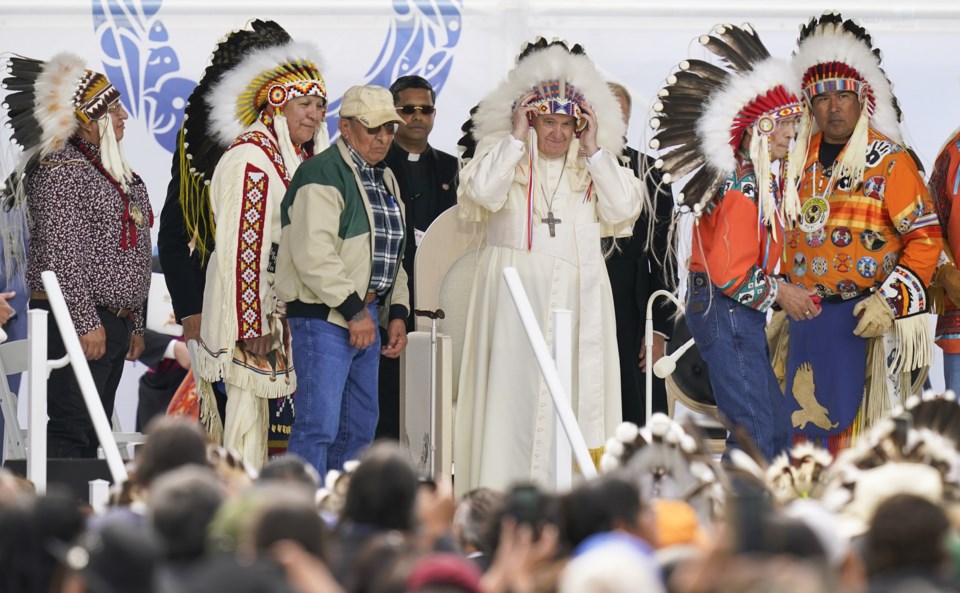It was a stunning image: Pope Francis briefly wearing a full Indigenous headdress, its rows of soft white feathers fastened in place by a colorful, beaded headband after for Indigenous children.
Chief Wilton Littlechild, a residential school survivor himself, gave Francis the headdress Monday, placing it on his head amid cheering by an audience in Maskwacis, Alberta, that included many school survivors.
The Vatican and the pope clearly appreciated the gesture: Francis kissed Littlechild’s hands after receiving the headdress, something he has done in the past as a sign of respect for Holocaust survivors, and has done on this trip for residential school survivors.
The Vatican obviously understood the symbolic significance of the moment, putting the photo on the front page of the Vatican newspaper L‚ÄôOsservatore Romano under the headline ‚ÄúI humbly beg forgiveness.‚ÄĚ
Headdresses historically are a symbol of respect, worn by Native American war chiefs and warriors. For many Plains tribes, for example, each feather placed on a headdress has significance and had to be earned through an act of compassion or bravery. Some modern-day Native American leaders have been given war bonnets in ceremonies accompanied by prayers and songs.
Yet this revered regalia also represents an image that has been co-opted from tribes in popular culture for decades, feeding stereotypes in everything from Hollywood films, to to
Some members of Indigenous tribes said they found the gesture incongruous with the past transgressions at church-run schools that Francis apologized for.
Russ Diabo, a member of the Kahnawake Mohawk tribe in Canada and an Indigenous advocate and policy analyst, described the scene as ‚Äúpageantry‚ÄĚ and the pope's statements as ‚Äúfacile."
Diabo said on Twitter it was "the Catholic Church and Canada collaborating in creating a mythology for a shared ‚ÄėReconciliation‚Äô agenda narrated by prominent federal collaborators/residential school survivors!‚ÄĚ
“I have so much to say about this, and all of it negative," tweeted Joe Horse Capture, vice president of native collections and curator of Native American History and Culture at the Autry Museum of the American West in Los Angeles.
"I am practicing ‚ÄėIf you can‚Äôt say anything positive, don‚Äôt say anything at all‚Äô mantra. But I‚Äôll be honest, it‚Äôs difficult!,‚ÄĚ added Horse Capture, a member of the A‚Äôaniiih Nation.
More than 150,000 Native children in Canada from the 19th century until the 1970s in an effort to isolate them from the influence of their homes and culture. The aim was to Christianize and assimilate them into mainstream society, which previous Canadian governments considered superior.
The discoveries of hundreds of in the past year have drawn international attention to the schools in Canada and their counterparts in the United States.
Leading U.S.-based Indigenous news outlet ICT made a deliberate decision to not make the war bonnet a focus of their papal visit coverage.
‚ÄúWhen I saw the headdress being placed on the Pope, I immediately thought ‚Äėabsolutely not.‚Äô We are not running that photo,‚ÄĚ said Jourdan Bennett-Begaye, editor of ICT, formerly Indian Country Today. ‚ÄúIt distracts readers from the Pope‚Äôs apology and survivors‚Äô stories who sat in those chairs listening to his every word. Something they‚Äôve been waiting for, for decades.
‚ÄúIt creates unnecessary noise regarding Indigenous peoples‚Äô choices where the real scrutiny should be placed on the Pope and that entire institution.‚ÄĚ
Maka Black Elk, executive director of Truth and Healing at Red Cloud Indian School in Pine Ridge, South Dakota, described the scene on Twitter as a "#toosoon moment.‚ÄĚ
‚ÄúThe discourse around the #PopeFrancis headdress is unfortunate," wrote Black Elk. "He did not request that. It wasn‚Äôt his fault. But it‚Äôs also clear the givers did not consider how it would make other Indigenous people feel.‚ÄĚ
Black Elk said later in a telephone interview that the mixed reaction to the headdress being placed on the pope's head ‚Äúreflects the reality of native people and our need for more dialogue‚ÄĚ about the past.
‚ÄúI do think that Chief Littlechild felt it was important to honor this moment, and this was a significant moment,‚ÄĚ he added.
A spokeswoman for Littlechild didn’t immediately respond Tuesday to a message seeking comment.
But Keeshon Littlechild used a Facebook post to defend his grandfather for giving Francis one of his own many headdresses.
‚ÄúBugs me to see people bashing my grandfather and I understand how much respect is needed to be gifted one but at the end of the day that was him showing the pope respect for coming all the way to maskwacis to apologize,‚ÄĚ he wrote.
Among those coming to Littlechild's defense was Phil Fontaine, a former Assembly of First Nations chief and a residential school survivor.
‚ÄúChief Littlechild followed his protocols,‚ÄĚ Fontaine said. "There is a protocol for that kind of gift. He went to the elders, he went to the leadership and requested permission to present that gift. It is entirely consistent with the way they follow their customs and protocol here.‚ÄĚ
Jon Crier, a First Nations elder and school survivor, said during a news conference after the apology that the gesture meant tribal leaders “adopted him as one of our leaders in the community.
"It‚Äôs an honoring of the man, it‚Äôs an honoring of the work he has done and it‚Äôs also recognizing ‚Ķ here‚Äôs a man that belongs in our tribe,‚ÄĚ Crier said.
Marie-Anne Day Walker Pelletier, former chief of Okanese First Nation, told CTV, ‚ÄúI thought it was pretty cool. The chief of all chiefs now I guess.‚ÄĚ
‚ÄĒ-
Nicole Winfield and Peter Smith in Maskwacis, Alberta, and Rob Gillies in Toronto contributed reporting. Snow reported from Phoenix.
‚ÄĒ‚∂ńĒ
Associated Press religion coverage receives support through the AP’s collaboration with The Conversation US, with funding from Lilly Endowment Inc. The AP is solely responsible for this content.
Anita Snow, The Associated Press



